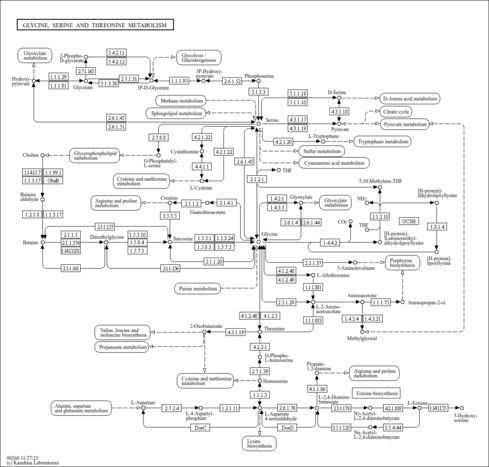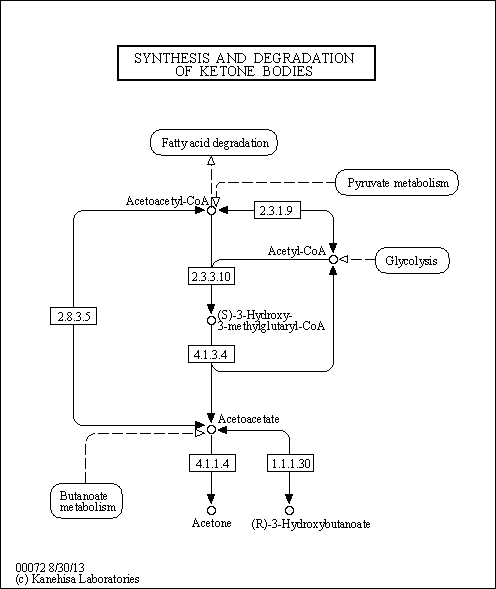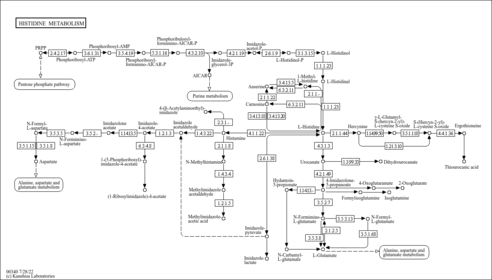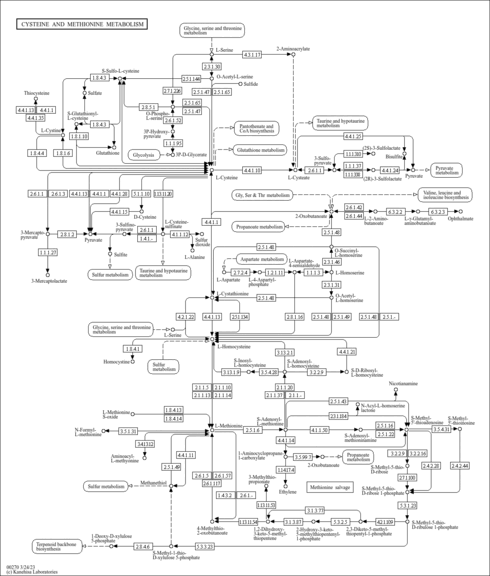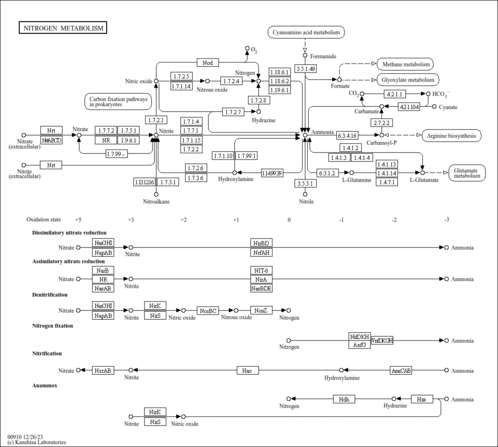| Pyruvate dehydrogenase E1 component subunit beta, mitochondrial | PDHB | 3p21.1-p14.2 | P11177 | details |
| Malonyl-CoA decarboxylase, mitochondrial | MLYCD | 16q24 | O95822 | details |
| 5-aminolevulinate synthase, erythroid-specific, mitochondrial | ALAS2 | Xp11.21 | P22557 | details |
| 5-aminolevulinate synthase, nonspecific, mitochondrial | ALAS1 | 3p21.1 | P13196 | details |
| Fatty acid synthase | FASN | 17q25 | P49327 | details |
| Pyruvate dehydrogenase E1 component subunit alpha, somatic form, mitochondrial | PDHA1 | Xp22.1 | P08559 | details |
| Pyruvate dehydrogenase E1 component subunit alpha, testis-specific form, mitochondrial | PDHA2 | 4q22-q23 | P29803 | details |
| Methylmalonate-semialdehyde dehydrogenase [acylating], mitochondrial | ALDH6A1 | 14q24.3 | Q02252 | details |
| Dihydrolipoyl dehydrogenase, mitochondrial | DLD | 7q31-q32 | P09622 | details |
| Dihydrolipoyllysine-residue acetyltransferase component of pyruvate dehydrogenase complex, mitochondrial | DLAT | 11q23.1 | P10515 | details |
| Tyrosinase | TYR | 11q14-q21 | P14679 | details |
| Glutaryl-CoA dehydrogenase, mitochondrial | GCDH | 19p13.2 | Q92947 | details |
| Lysosomal acid lipase/cholesteryl ester hydrolase | LIPA | 10q23.2-q23.3 | P38571 | details |
| Uroporphyrinogen decarboxylase | UROD | 1p34 | P06132 | details |
| Coproporphyrinogen-III oxidase, mitochondrial | CPOX | 3q12 | P36551 | details |
| 2-amino-3-carboxymuconate-6-semialdehyde decarboxylase | ACMSD | 2q21.3 | Q8TDX5 | details |
| Methylsterol monooxygenase 1 | MSMO1 | 4q32-q34 | Q15800 | details |
| Sterol-4-alpha-carboxylate 3-dehydrogenase, decarboxylating | NSDHL | Xq28 | Q15738 | details |
| Phytanoyl-CoA dioxygenase, peroxisomal | PHYH | 10p13 | O14832 | details |
| Aromatic-L-amino-acid decarboxylase | DDC | 7p12.2 | P20711 | details |
| Peroxiredoxin-6 | PRDX6 | 1q25.1 | P30041 | details |
| 2-oxoisovalerate dehydrogenase subunit beta, mitochondrial | BCKDHB | 6q14.1 | P21953 | details |
| 2-oxoisovalerate dehydrogenase subunit alpha, mitochondrial | BCKDHA | 19q13.1-q13.2 | P12694 | details |
| Prolyl 4-hydroxylase subunit alpha-2 | P4HA2 | 5q31 | O15460 | details |
| Prolyl 4-hydroxylase subunit alpha-1 | P4HA1 | 10q21.3-q23.1 | P13674 | details |
| Nicotinate-nucleotide pyrophosphorylase [carboxylating] | QPRT | 16p11.2 | Q15274 | details |
| Carbamoyl-phosphate synthase [ammonia], mitochondrial | CPS1 | 2q35 | P31327 | details |
| Gamma-butyrobetaine dioxygenase | BBOX1 | 11p14.2 | O75936 | details |
| S-adenosylmethionine decarboxylase proenzyme | AMD1 | 6q21 | P17707 | details |
| 2-oxoglutarate dehydrogenase, mitochondrial | OGDH | 7p14-p13 | Q02218 | details |
| Procollagen-lysine,2-oxoglutarate 5-dioxygenase 1 | PLOD1 | 1p36.22 | Q02809 | details |
| Procollagen-lysine,2-oxoglutarate 5-dioxygenase 2 | PLOD2 | 3q24 | O00469 | details |
| Procollagen-lysine,2-oxoglutarate 5-dioxygenase 3 | PLOD3 | 7q22 | O60568 | details |
| Liver carboxylesterase 1 | CES1 | 16q22.2 | P23141 | details |
| Cocaine esterase | CES2 | 16q22.1 | O00748 | details |
| Beta-ureidopropionase | UPB1 | 22q11.2 | Q9UBR1 | details |
| Aminomethyltransferase, mitochondrial | AMT | 3p21.2-p21.1 | P48728 | details |
| Glutamate decarboxylase 2 | GAD2 | 10p11.23 | Q05329 | details |
| Glutamate decarboxylase 1 | GAD1 | 2q31 | Q99259 | details |
| Gamma-glutamyltranspeptidase 1 | GGT1 | 22q11.23 | P19440 | details |
| Pyruvate kinase isozymes M1/M2 | PKM | 15q22 | P14618 | details |
| Pyruvate kinase isozymes R/L | PKLR | 1q21 | P30613 | details |
| Glycine dehydrogenase [decarboxylating], mitochondrial | GLDC | 9p22 | P23378 | details |
| 4-hydroxyphenylpyruvate dioxygenase | HPD | 12q24-qter | P32754 | details |
| 3-keto-steroid reductase | HSD17B7 | 1q23 | P56937 | details |
| Histidine decarboxylase | HDC | 15q21-q22 | P19113 | details |
| Serine palmitoyltransferase 1 | SPTLC1 | 9q22.2 | O15269 | details |
| Serine palmitoyltransferase 2 | SPTLC2 | 14q24.3 | O15270 | details |
| Phosphoenolpyruvate carboxykinase [GTP], mitochondrial | PCK2 | 14q11.2 | Q16822 | details |
| Phosphoenolpyruvate carboxykinase, cytosolic [GTP] | PCK1 | 20q13.31 | P35558 | details |
| Multifunctional protein ADE2 | PAICS | 4q12 | P22234 | details |
| Isocitrate dehydrogenase [NADP], mitochondrial | IDH2 | 15q26.1 | P48735 | details |
| Isocitrate dehydrogenase [NAD] subunit beta, mitochondrial | IDH3B | 20p13 | O43837 | details |
| Isocitrate dehydrogenase [NADP] cytoplasmic | IDH1 | 2q33.3 | O75874 | details |
| Isocitrate dehydrogenase [NAD] subunit alpha, mitochondrial | IDH3A | 15q25.1-q25.2 | P50213 | details |
| Isocitrate dehydrogenase [NAD] subunit gamma, mitochondrial | IDH3G | Xq28 | P51553 | details |
| Cysteine sulfinic acid decarboxylase | CSAD | 12q13.11-q14.3 | Q9Y600 | details |
| Cytosolic 10-formyltetrahydrofolate dehydrogenase | ALDH1L1 | 3q21.3 | O75891 | details |
| Diphosphomevalonate decarboxylase | MVD | 16q24.3 | P53602 | details |
| Aspartyl/asparaginyl beta-hydroxylase | ASPH | 8q12.1 | Q12797 | details |
| Ornithine decarboxylase | ODC1 | 2p25 | P11926 | details |
| 6-phosphogluconate dehydrogenase, decarboxylating | PGD | 1p36.22 | P52209 | details |
| Uridine 5'-monophosphate synthase | UMPS | 3q13 | P11172 | details |
| Vitamin K-dependent gamma-carboxylase | GGCX | 2p12 | P38435 | details |
| Carbonic anhydrase 1 | CA1 | 8q21.2 | P00915 | details |
| Carbonic anhydrase 2 | CA2 | 8q22 | P00918 | details |
| Arginine decarboxylase | ADC | 1p35.1 | Q96A70 | details |
| Phosphatidylserine decarboxylase proenzyme | PISD | 22q12.2 | Q9UG56 | details |
| Carbonic anhydrase 5A, mitochondrial | CA5A | 16q24.3 | P35218 | details |
| Carbonic anhydrase 3 | CA3 | 8q21.2 | P07451 | details |
| Carbonic anhydrase 5B, mitochondrial | CA5B | Xp21.1 | Q9Y2D0 | details |
| Glycine cleavage system H protein, mitochondrial | GCSH | | P23434 | details |
| Carbonic anhydrase 12 | CA12 | 15q22 | O43570 | details |
| Phosphopantothenoylcysteine decarboxylase | PPCDC | 15q24.2 | Q96CD2 | details |
| Carbonic anhydrase 4 | CA4 | 17q23 | P22748 | details |
| UDP-glucuronic acid decarboxylase 1 | UXS1 | 2q12.2 | Q8NBZ7 | details |
| Carbonic anhydrase 9 | CA9 | 9p13.3 | Q16790 | details |
| Carbonic anhydrase 13 | CA13 | 8q21.2 | Q8N1Q1 | details |
| Trimethyllysine dioxygenase, mitochondrial | TMLHE | Xq28 | Q9NVH6 | details |
| Elongation of very long chain fatty acids protein 4 | ELOVL4 | 6q14 | Q9GZR5 | details |
| Carbonic anhydrase 14 | CA14 | 1q21 | Q9ULX7 | details |
| Carbonic anhydrase 7 | CA7 | 16q22.1 | P43166 | details |
| Mitochondrial 10-formyltetrahydrofolate dehydrogenase | ALDH1L2 | 12q23.3 | Q3SY69 | details |
| Gamma-glutamyltransferase 6 | GGT6 | 17p13.2 | Q6P531 | details |
| Putative uncharacterized protein PGD | PGD | 1p36.3-p36.13 | A9Z1X1 | details |
| Serine palmitoyltransferase 3 | SPTLC3 | 20p12.1 | Q9NUV7 | details |
| 2-oxoglutarate dehydrogenase-like, mitochondrial | OGDHL | | Q9ULD0 | details |
| Prolyl 4-hydroxylase subunit alpha-3 | P4HA3 | 11q13.4 | Q7Z4N8 | details |
| Lysine-specific demethylase 2A | KDM2A | 11q13.2 | Q9Y2K7 | details |
| Lysine-specific demethylase 2B | KDM2B | 12q24.31 | Q8NHM5 | details |
| 3-oxoacyl-[acyl-carrier-protein] synthase, mitochondrial | OXSM | 3p24.2 | Q9NWU1 | details |
| GGT7 protein | GGT7 | 20q11.22 | A0PJJ9 | details |
| Gamma-glutamyltransferase 5 | GGT5 | 22q11.23 | P36269 | details |
| Carbonic anhydrase 6 | CA6 | 1p36.2 | P23280 | details |
| Carboxylesterase 5A | CES5A | 16q12.2 | Q6NT32 | details |
| D-dopachrome decarboxylase | DDT | 22q11.23 | P30046 | details |
| Carbonic anhydrase-related protein | CA8 | | P35219 | details |
